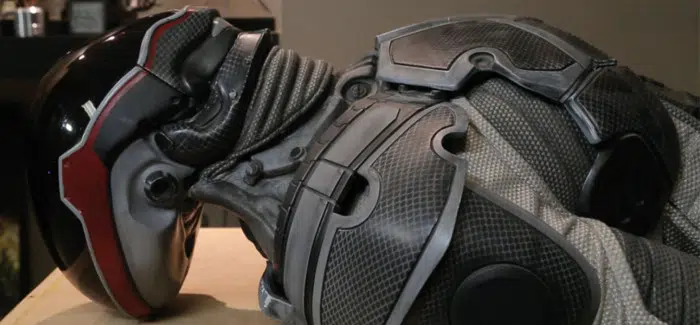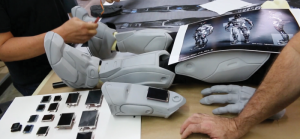We’re all under the rule of extra-terrestrial invaders in USA Networks’ new sci-fi drama, Colony. Mysteriously unseen, they’ve surrounded cities across the globe with giant walls and employ a military regime of humans to brutally govern mankind. As the plot unfolds in Los Angeles within the near future, you’re left wondering who or what is behind it.
For the finale of the first season, we moved one step closer to finding out. What we saw seemed almost too real: a chiseled, tech-smart exoskeleton, a helmet fit for an oblong head, a menacing pitch-black visor, and underneath, the alien itself.
What you didn’t see —or would ever suspect— is that most of the exoskeleton was 3D printed on a MakerBot Replicator Z18 at Legacy Effects Studios.
Behind the Special Effects
Known for work on blockbusters like The Revenant, Iron Man 2, and Avatar, Legacy Effects Studios is a live-action, practical special effects company capable of making the unbelievable believable. Through a unique combination of artistry and leading technologies, Legacy Effects create everything from animatronic animals to puppets to futuristic suits to robots to costumes and more.
The producers from Colony came to Legacy Effects about doing an exoskeleton in July of 2015 on a tight budget. For suits, 3D printing can remove the costly, time-consuming steps of casting and molding done in the past. Creating 3D models on a computer also ensures a design is precisely symmetrical and will move properly.
Even though the company has industrial 3D printers, printing the suit with these would cost tens of thousands of dollars in materials. That’s where the company’s Lead System Engineer, MakerBot power-user, and 3D-printing whiz, Jason Lopes could help.
He needed a reliable solution with a large build volume, sturdy affordable filament, and remote monitoring. Since the Z18 prints with PLA, it costs much less and is sturdy. If it wasn’t sturdy, the suit could break in transport or on the set, which could cost more time and money during a shoot.
Once Lopes chose the Z18, he printed all the pieces of the exoskeleton in less than two weeks. He sums it up with, “I didn’t have one failed build on that entire suit and the end result was exactly what we needed”. In fact, a few of the pieces took more than sixty hours to print.
For Lopes, remote monitoring with the MakerBot Mobile app is actually very important. There are so many 3D printing projects at Legacy that it’s cost-effective to keep all 3D printers going. So, if he’s away and the Z18 finishes, he needs to know. Once it’s done, he can have a colleague clear the build plate for the next print.
After the Z18, the talented crew of artists at Legacy Effects then painted, polished, and touched-up the suit. They also installed electronics, added in the visor, and attached any fabric.
Continuing a Legacy
Lopes and Legacy Effects do plenty with their two MakerBot Z18 printers and one Replicator 2. Lopes introduces new designers to 3D printing with these 3D printers, since they’re designed for accessibility.
The company also gives clients like directors or producers inexpensive 3D-printed maquettes. These mini-models give clients a feel for how the full-scale end-product of a creature or suit will look in light from different angles for filming. Additionally, they can speed-up the client approval process as an idea goes from 3D design to maquette to production-ready piece.
With savvy technologists like Lopes and an arsenal of artists, Legacy Effects are constantly pushing past what’s possible. On the topic of 3D printing, co-founder Alan Scott sees this process going full-circle: “We’re on the cutting edge of what’s happening. You get to showcase the technology to people and it inspires them to used it in ways we wouldn’t have thought of.”



